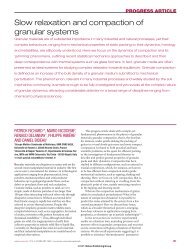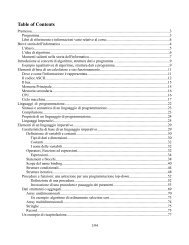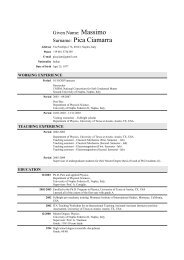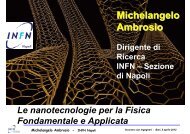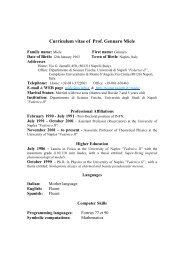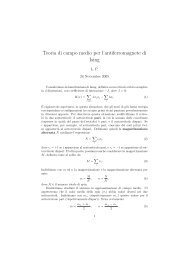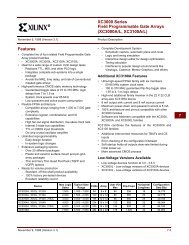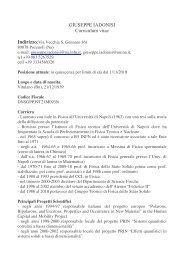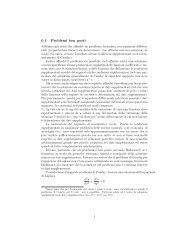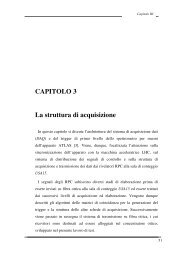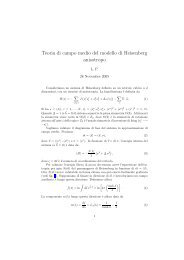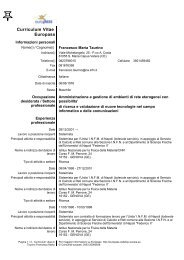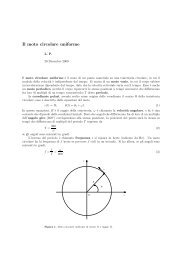Phys Rev E
Phys Rev E
Phys Rev E
Create successful ePaper yourself
Turn your PDF publications into a flip-book with our unique Google optimized e-Paper software.
LIGHT-INDUCED ROTATION OF DYE-DOPED LIQUID¼ PHYSICAL REVIEW E 73, 051707 2006<br />
anisotropy. Neglecting all magnetic effects at optical frequencies,<br />
the electromagnetic torque density is then given by<br />
em = D E = 0 an · En E, 7<br />
where D is the usual dielectric displacement field D i<br />
= ijE j and where denotes a time average over an optical<br />
cycle. The electromagnetic stress tensor can be written in the<br />
following form 13,16:<br />
em<br />
tji =F ˜<br />
em − F˜ 0 em<br />
ji + DjEi + BjBi/ , 8<br />
<br />
where 0 is the vacuum magnetic permittivity constant and<br />
F˜ em is the electromagnetic free energy density at given electric<br />
field E and magnetic field strength H=B/ 0, which in<br />
our case can be written as<br />
F˜<br />
em =− 1<br />
2 ijEiEj − B2<br />
=−<br />
20 0 2 ij + anin jEiE j − B2<br />
.<br />
20 9<br />
Let us finally consider the photoinduced terms, i.e., those<br />
appearing in dye-doped liquid crystals when illuminated with<br />
light having a wavelength falling within the dye absorption<br />
band. These are absolutely nonstandard. In the limit of small<br />
light intensities, simple symmetry arguments show that the<br />
photoinduced torque density must be identical to the electromagnetic<br />
one except for the replacement of the dielectric<br />
anisotropy a with a new material constant , proportional to<br />
the absorbance or to dye concentration 5. Therefore its<br />
explicit expression can be written as follows:<br />
ph = 0n · En E 10<br />
the constant 0 is inserted for making dimensionless.<br />
Similarly, we may apply symmetry arguments for identifying<br />
the most general possible expression of the photoinduced<br />
stress tensor. This expression contains seven unknown material<br />
constants all proportional to the absorbance:<br />
ph<br />
tij = a1E2 + a2n · E2ij + a3EiE j + a4E2 + a5n · E2nin j + n · Ea6Ein j + a7Ejni. 11<br />
The effects of this stress tensor have not been measured or<br />
even detected in ordinary liquid crystals, although related<br />
photoinduced effects may have been observed in polymeric<br />
nematic elastomers 17,18.<br />
We have thus completed the set of constitutive equations<br />
needed to close the dynamical equations 1 and 2.<br />
C. Angular momentum conservation<br />
Before moving on to the specific case of a droplet of<br />
liquid crystal immersed in water, it is convenient to see how<br />
the law of angular momentum conservation enters our problem.<br />
In contrast to the case of the conservation of linear momentum,<br />
which provides an additional dynamical equation,<br />
the law of angular momentum conservation actually sets<br />
only a general constraint on the possible constitutive laws of<br />
051707-3<br />
torque densities and stress tensors. For any given volume V<br />
of material, the corresponding angular momentum rate of<br />
change will be given by the following law:<br />
dL<br />
dt = Mtot , 12<br />
where L is the total angular momentum within volume V and<br />
M tot is the total external torque acting on it. The two sides of<br />
Eq. 12 can be deduced by multiplying the corresponding<br />
sides of Eq. 2 vectorially by r, integrating them over the<br />
volume V, and then adding to them the volume integral of<br />
the corresponding sides of Eq. 1. In this way we obtain<br />
and M tot = M , with<br />
L = Vr v + I nn dn<br />
dtdV 13<br />
<br />
Mi = ijhxjktkh + i dV, 14<br />
V<br />
where ijh is the fully antisymmetric Levi-Civita tensor 19.<br />
However, in order for Eq. 12 to be equivalent to a local<br />
conservation continuity law, it should be possible to reduce<br />
the total external torque to a pure surface integral over the<br />
boundary V of V, such as the following:<br />
<br />
Mi = ijhxjtkh + njskhdAk, 15<br />
V<br />
<br />
where skh is a material tensor expressing the torque per unit<br />
area exchanged by the director n directly through the surface<br />
and dAk denotes a vector having direction equal to the local<br />
surface normal pointing outward and modulus equal to the<br />
area of the surface element 14,15.<br />
By equating the two expressions 14 and 15 of the external<br />
torque for any possible volume V, and exploiting the<br />
standard divergence theorems, one obtains the local identity<br />
<br />
i = ijhtjh + kijhnjskh. 16<br />
Generally speaking, this identity holds true only for =tot,<br />
and not separately for each term =hp,el,vis,em,ph. However,<br />
since in our first-order theory these five terms can be<br />
tuned independently from each other, identity 16 must hold<br />
true also for =hp,el,vis,em,ph, separately.<br />
Moreover, since in the first-order approximation only the<br />
elastic forces torque density and stress tensor are taken to<br />
depend on the director spatial gradients, we may deduce<br />
<br />
from Eq. 16 that skh is nonzero only for the elastic contribution<br />
=el. In all other cases one must have s =0 within<br />
first-order approximation. Therefore in these cases, owing to<br />
angular momentum conservation, the stress tensor defines<br />
completely the torque density, or conversely, the torque density<br />
defines the antisymmetric part of the stress tensor. In<br />
particular, Eq. 16 with =ph yields the following relationship<br />
between the material constants appearing in expressions<br />
10 and 11:



